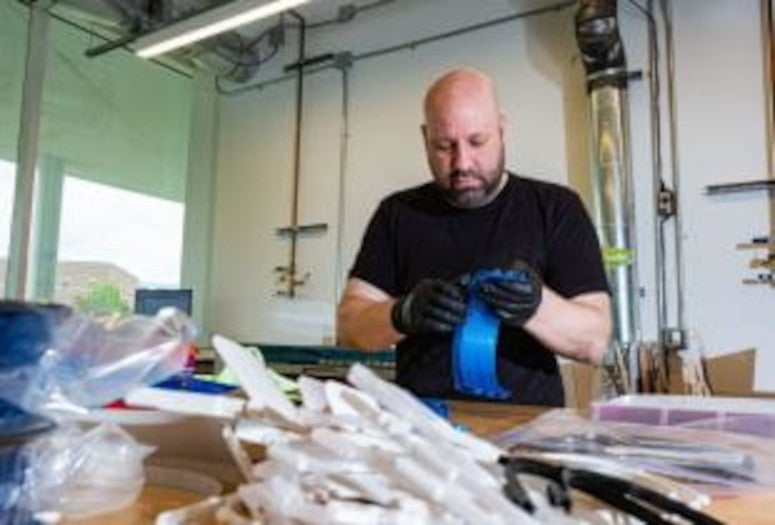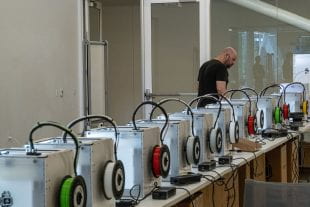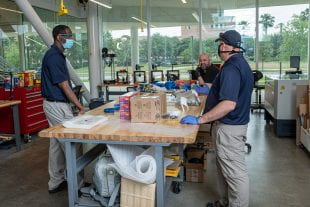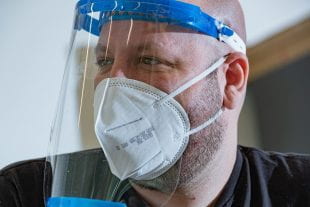In the two-story studio space at Rice’s Moody Center for the Arts that normally houses student projects, tables and chairs have been cleared out to make room for 15 massive 3D printers, which are now running at capacity all day long.
The art center has been converted into a manufacturing center. Under the watchful eyes of Rob Purvis, the director of the workshop and makerspace at the Moody Center, the 3D printers are creating face shields for medical workers on the front lines of the fight against COVID-19.
“It’s awesome to be able to turn this stuff around, and to actually provide something of real, meaningful benefit,” Purvis said.
They’re aiming to print at least 5,000 face shields. For now.
It’s all part of Rice’s COVID-19 response team, a massive campuswide effort coordinated across departments from civil engineering to the arts. Pooling resources in this way and encouraging faculty and staff across campus to bring their individual strengths to the table, Purvis said, allowed him to ramp up production in less than a week.
“Being able to kind of funnel everything through one group is really the main benefit,” Purvis said. “It's Rice as a whole community providing for its city and making the right decisions with the right people.”
During a typical semester, Purvis is busy helping students create projects and artists install their work in the Moody Center’s galleries. He oversees a tech-filled, 5,000-square-foot fabrication facility with a wood shop, metal shop, spray paint booth and – crucially -- four 3D printers.
So when students were sent home for the semester and Purvis saw the need for personal protective equipment rising nationwide, he knew the Moody could help out.
Rapid prototyping is one of the workshop’s specialties. Purvis quickly printed up a variety of face shields based on existing designs he found online. Then he began putting out feelers to see if anyone on campus knew a good way to distribute the Moody’s shields to local health care professionals.
That’s how he met Fred Higgs and the team at the Rice Center for Engineering Leadership, who’s spearheading Rice’s COVID-19 response team. With the Oshman Engineering Design Kitchen busy creating emergency ventilators, Higgs was hoping to find a space on campus with 3D printing and prototyping capabilities. Purvis had all that and more, including connections with material suppliers — but he didn’t have the contacts to distribute the face shields he’d already printed.
Across campus in the engineering department, Purvis said, “they were unaware that I have a full-on professional machining, quality manufacturing facility here at the Moody.” What’s more, a friend who’s worked with Purvis on Rice projects in the past offered to loan out some of his company’s idle equipment for whatever the campus needed. Within days, Ultimaker had shipped 15 of its 3D printers to Rice.
The printers stood at the ready while the COVID-19 team researched the best and most critically needed face shields for medical professionals. Getting the design right was crucial, Purvis said; otherwise, the gear would go unused.
“We don't want to do something just to do say that we did something,” he said. “We want to actually do something that's going to make a difference.”
Depending on the design used, the printers at the Moody Center can fabricate anywhere from 130 face shields per day to 1,400. It’s not a full-tilt injection molding facility that can make 50,000 per day, Purvis pointed out, but it’s enough to help address the immediate needs of the impending coronavirus spike in Harris County.
And a day will come, of course, when students are back on campus. The studio space will again be filled with art instead of 3D printers, and the 3D printers in the Moody’s makerspace will once again be put to work crafting holiday gifts or passion projects. Purvis is hoping to see some new faces in the shops, thanks to the relationships he’s already made with faculty and students through the COVID-19 response team.
“This will be over with and things will go back to normal,” Purvis said. “Hopefully, long-term, more students will be aware of this resource they have available to them and they’ll come take advantage of it.”




